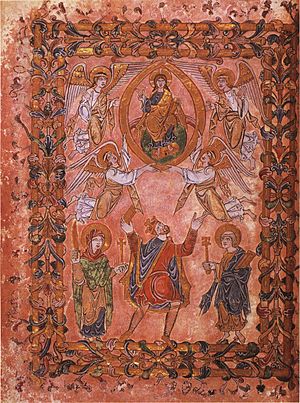New Minster, Winchester facts for kids

The New Minster in Winchester was a royal Benedictine abbey (a type of monastery) founded in 901. It was located in the city of Winchester in Hampshire, England. This abbey played a big role in early English history.
Contents
Building a New Monastery
Alfred the Great, a famous English king, first planned to build this monastery. He managed to buy the land for it. However, he passed away before he could finish the project.
His son, Edward the Elder, took over. He completed the New Minster just as his father had wished. He got help from a holy person named Saint Grimbald, who became the first leader, or abbot, of the monastery.
The New Minster was built very close to another old church, the Old Minster. They were so close that when the monks sang, their voices mixed together. This sometimes caused a lot of noise!
A Place for Important Burials
The New Minster became a very important place for burials. King Alfred the Great's body was moved there. Saint Grimbald was also buried there.
Later, the body of Saint Judoc, a holy person from Brittany, was also brought to the New Minster. This made the abbey a popular place for pilgrimage. People would travel long distances to visit these holy graves.
In 963, the New Minster officially became a Benedictine house. This meant it followed the rules of the Benedictine order of monks.
Changes Over Time
In 972, King Edgar ordered the church of the New Minster to be formally dedicated. This means it was officially opened for religious use. His father, King Edmund, had started some work on the church, but Edgar finished it.
Later, in 1041, Queen Emma added a special holy item: the head of Saint Valentine. This made the abbey even more important.
After the Norman Conquest of England in 1066, a new cathedral was built in Winchester. Because of this, the monks of New Minster had to move. They moved to a place called Hyde Mead, just outside the city walls. This new location became known as Hyde Abbey.
Important People Buried Here
Many important figures from early English history were buried at New Minster:

